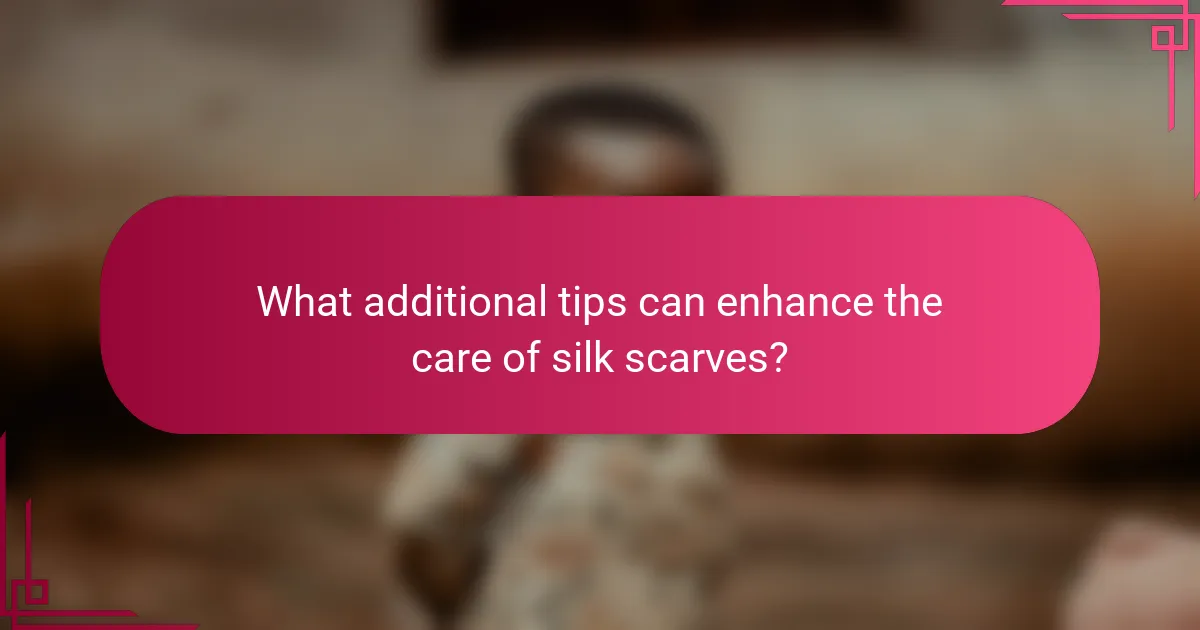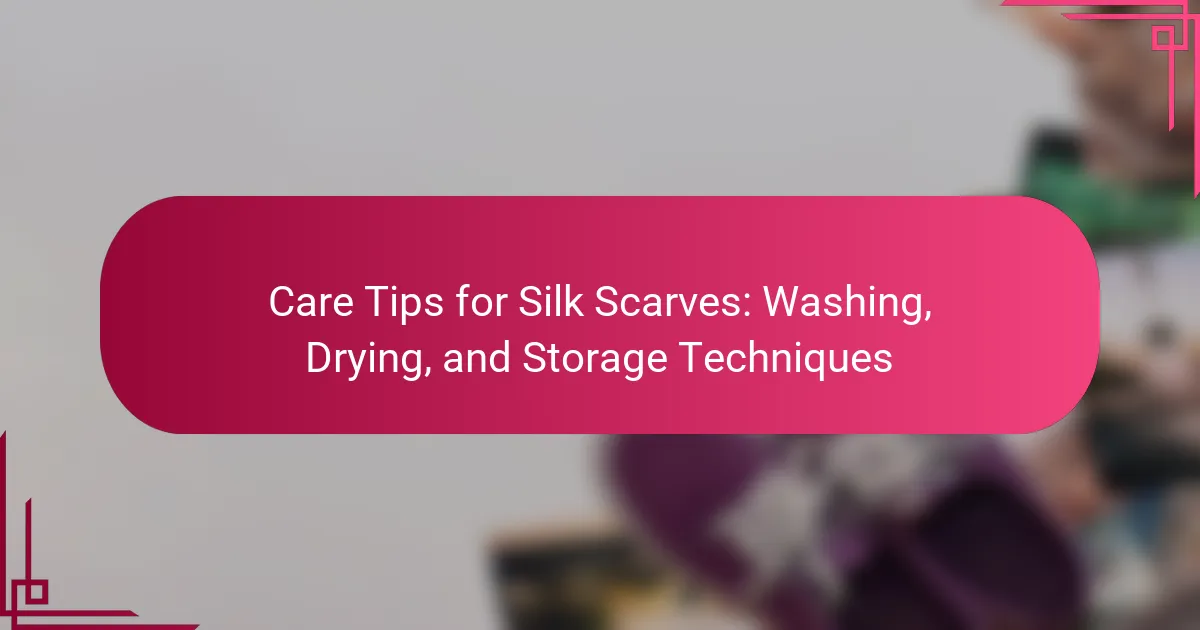Silk scarves require specific care to maintain their quality and appearance over time. Essential care tips include gentle washing in cold water with a mild detergent, avoiding bleach or harsh chemicals that can damage the fabric. Proper drying methods involve air drying away from direct sunlight to prevent fading, while appropriate storage techniques recommend rolling or folding scarves to avoid creasing. Regular maintenance, such as checking for signs of wear and using breathable fabric bags for storage, is crucial for preserving the integrity of silk scarves. These practices ensure that silk scarves remain beautiful and intact for years.

What are the essential care tips for silk scarves?
The essential care tips for silk scarves include gentle washing, proper drying, and appropriate storage. Hand wash silk scarves in cold water with a mild detergent. Avoid using bleach or harsh chemicals, as they can damage the fabric. Rinse thoroughly to remove all soap residues. Lay the scarf flat on a clean, dry towel to absorb excess water. Do not wring or twist the scarf, as this can cause stretching. Hang the scarf to air dry away from direct sunlight to prevent fading. Store silk scarves in a cool, dry place, preferably rolled or folded in a way that avoids creasing. Avoid hanging silk scarves on hangers for long periods, as this can cause them to lose shape.
How should silk scarves be washed properly?
Silk scarves should be washed by hand in cold water using a gentle detergent. Fill a basin with cold water and add a few drops of the detergent. Submerge the silk scarf and gently agitate the water without twisting or rubbing the fabric. Rinse the scarf thoroughly in cold water until all detergent is removed. Avoid wringing the scarf; instead, lay it flat on a clean towel to absorb excess water. Hang the scarf to dry away from direct sunlight. This method prevents damage and maintains the scarf’s quality.
What are the recommended washing methods for silk scarves?
The recommended washing methods for silk scarves include hand washing and dry cleaning. Hand washing is preferred to maintain the fabric’s integrity. Use cold water and a gentle detergent specifically designed for silk. Avoid wringing or twisting the scarf, as this can damage the fibers. Instead, gently press the water out. Rinse thoroughly to remove all soap. For dry cleaning, choose a reputable cleaner experienced with silk fabrics. This method ensures that the scarf retains its color and shape. Following these methods helps preserve the quality of silk scarves over time.
What detergents are safe for washing silk scarves?
Gentle detergents are safe for washing silk scarves. Look for pH-neutral or silk-specific detergents. Brands like Eucalan and The Laundress offer products designed for silk. These detergents help preserve the fabric’s natural fibers. Avoid harsh chemicals and bleach, as they can damage silk. Always follow the care label instructions on your scarf. Hand washing is recommended for the best results.
Why is the drying process important for silk scarves?
The drying process is crucial for silk scarves to maintain their quality and appearance. Proper drying prevents damage such as shrinkage or distortion. Silk is a delicate fabric that can lose its shape when exposed to excessive moisture. Air drying is recommended to retain the scarf’s natural luster and softness. Using heat sources like dryers can cause irreversible damage to the fibers. Additionally, drying silk scarves in direct sunlight can lead to color fading. Following these drying guidelines ensures the longevity of the scarf while preserving its aesthetic appeal.
What are the best practices for drying silk scarves?
The best practices for drying silk scarves include air drying them flat and avoiding direct sunlight. Silk is delicate and can be damaged by heat, so using a flat surface prevents distortion. Place a clean, dry towel under the scarf to absorb moisture. Gently reshape the scarf to its original form while it is damp. Avoid wringing or twisting the fabric, as this can lead to creases. Instead, let the scarf dry naturally in a well-ventilated area. Following these methods preserves the integrity and appearance of silk scarves.
How can you avoid damaging silk scarves during drying?
To avoid damaging silk scarves during drying, always lay them flat on a clean, dry towel. This prevents stretching and maintains the scarf’s shape. Avoid hanging silk scarves, as this can cause them to stretch out of shape. Do not use a dryer, as high heat can damage the delicate fibers. Instead, gently roll the towel with the scarf inside to absorb excess water. Once damp, reshape the scarf and lay it flat on another dry towel. Keep the scarf away from direct sunlight, as UV rays can fade colors. Following these steps ensures the longevity and quality of silk scarves.
What are the best storage techniques for silk scarves?
The best storage techniques for silk scarves include rolling, hanging, and using acid-free tissue paper. Rolling prevents creases and maintains the fabric’s integrity. Hanging silk scarves on padded hangers avoids folding and reduces wrinkles. Using acid-free tissue paper between layers when stacking scarves protects them from friction and color transfer. These methods help preserve the quality and appearance of silk scarves over time.
How should silk scarves be folded for storage?
Silk scarves should be folded gently to prevent creases and damage. Start by laying the scarf flat on a clean surface. Fold the scarf in half lengthwise, aligning the edges. Next, fold it in half again to create a narrower strip. Roll the scarf from one end to the other for compact storage. This method minimizes wrinkles and preserves the fabric’s quality. Proper folding techniques help maintain the scarf’s shape and prevent snagging. Storing silk scarves in a cool, dry place enhances their longevity.
What storage materials are ideal for silk scarves?
The ideal storage materials for silk scarves are cotton, silk, and acid-free tissue paper. Cotton allows breathability and prevents moisture buildup. Silk provides a soft surface that prevents friction damage. Acid-free tissue paper helps maintain shape and prevents creasing. These materials help protect the delicate fibers of silk scarves from damage. Storing silk scarves in these materials can prolong their lifespan significantly.

How can you maintain the quality of silk scarves over time?
To maintain the quality of silk scarves over time, proper care is essential. Hand washing in cold water with a gentle detergent preserves the fabric’s integrity. Avoid using bleach or harsh chemicals, as they can damage silk fibers. Air drying is recommended; hang scarves away from direct sunlight to prevent fading. Store silk scarves flat or rolled to avoid creasing. Use breathable fabric bags for storage to protect against dust. Regularly check for signs of wear or color fading, and address issues promptly to prolong their lifespan. These practices help ensure silk scarves remain beautiful and intact for years.
What common mistakes should be avoided when caring for silk scarves?
Common mistakes to avoid when caring for silk scarves include using harsh detergents. Harsh chemicals can damage silk fibers. Another mistake is washing silk in hot water. Hot water can cause shrinkage and fading. Additionally, avoid wringing or twisting silk scarves. This can lead to creases and distortion. Storing silk scarves improperly is also a mistake. They should be rolled or folded gently to prevent creasing. Lastly, exposing silk to direct sunlight can fade its colors. Protecting silk scarves from light helps maintain their vibrancy.
How can improper washing affect silk scarf longevity?
Improper washing can significantly reduce the longevity of a silk scarf. Silk is a delicate fabric that requires specific care. Using harsh detergents can damage the fibers, leading to fraying and discoloration. High temperatures during washing can cause shrinkage and loss of shape. Additionally, aggressive scrubbing can weaken silk, making it prone to tears. A study from the Textile Research Journal shows that improper washing can decrease fabric strength by up to 30%. Therefore, following proper washing techniques is essential for maintaining a silk scarf’s quality and lifespan.
What are the risks of incorrect storage for silk scarves?
Incorrect storage of silk scarves can lead to damage such as fading, creasing, and mildew growth. Exposure to direct sunlight can cause colors to fade over time. Storing silk in damp environments can promote mildew, which can ruin the fabric. Folding silk scarves improperly can create permanent creases. Additionally, storing silk with rough materials can result in snags and tears. Using non-breathable containers can trap moisture and lead to deterioration. Proper storage is essential to maintain the quality and longevity of silk scarves.
Why is it important to check for damage before washing silk scarves?
It is important to check for damage before washing silk scarves to prevent further deterioration. Silk is a delicate fabric that can be easily harmed by improper washing. Inspecting for tears, frays, or discoloration helps identify issues that need attention. Washing damaged silk can lead to more extensive damage, such as larger tears or loss of color. Additionally, damaged areas may not withstand the washing process, resulting in irreversible harm. Ensuring the scarf is in good condition allows for safe cleaning and preserves its longevity. Regular checks can enhance the overall care and maintenance of silk scarves.
What signs of damage should you look for on silk scarves?
Look for frayed edges on silk scarves. Fraying indicates wear and potential unraveling. Check for discoloration or fading. This suggests exposure to sunlight or harsh chemicals. Inspect for stains, which can be difficult to remove if not treated promptly. Look for holes or tears; these indicate significant damage. Examine the fabric for stiffness or roughness, which can signal deterioration. Lastly, check for any unusual odors, as this can indicate improper storage or cleaning.
How can you repair minor damages on silk scarves?
To repair minor damages on silk scarves, identify the type of damage first. For small snags, gently pull the snagged thread to the back of the fabric. Use a needle to tuck the thread in and secure it. For small holes, apply a fabric adhesive on the underside of the hole. Place a small piece of silk fabric over the adhesive for reinforcement. Allow the adhesive to dry completely as per the manufacturer’s instructions. For minor stains, use a silk-safe stain remover and blot gently with a clean cloth. Rinse with cold water and let it air dry. These methods are effective for maintaining the integrity of silk scarves.

What additional tips can enhance the care of silk scarves?
To enhance the care of silk scarves, store them flat or rolled to prevent creasing. Avoid hanging them, as this can stretch the fibers. Use a silk-specific detergent for washing to maintain fabric integrity. Hand wash in cold water to prevent damage. Avoid direct sunlight when drying to prevent fading. Iron on a low setting while using a cloth barrier to protect the fabric. Regularly rotate scarves in your collection to minimize wear on any single piece. These practices help preserve the quality and appearance of silk scarves over time.
How can you refresh silk scarves without washing them?
To refresh silk scarves without washing them, use a fabric steamer or iron on a low setting. The steam helps remove wrinkles and odors. Hang the scarf in a steamy bathroom for a few minutes. This method allows moisture to penetrate the fabric gently. Alternatively, place the scarf in a mesh bag and tumble dry on low with a damp cloth. This adds moisture without direct washing. Another option is to lightly spritz the scarf with a mixture of water and fabric conditioner. This can refresh the scent and softness. Always ensure the silk is not exposed to high heat or direct water. These methods maintain the scarf’s quality while keeping it fresh.
What methods can be used to remove odors from silk scarves?
To remove odors from silk scarves, several effective methods can be employed. One method is to air out the scarf by hanging it in a well-ventilated area. Fresh air can help dissipate unwanted smells. Another option is to use a fabric freshener spray specifically designed for delicate fabrics. This can mask and neutralize odors without damaging the silk.
Additionally, placing the scarf in a sealed bag with baking soda for a few hours can absorb odors effectively. Baking soda is known for its odor-neutralizing properties. Another technique involves using a mixture of water and white vinegar. Lightly misting the scarf with this solution can help remove smells while also acting as a natural disinfectant.
Lastly, dry cleaning is a reliable method for stubborn odors. Professional cleaners have specialized techniques for treating silk without causing damage. These methods are widely recommended for maintaining the quality and freshness of silk scarves.
How can steaming help maintain the appearance of silk scarves?
Steaming can help maintain the appearance of silk scarves by removing wrinkles and refreshing the fabric. The gentle heat from steam relaxes the fibers without causing damage. This method is safer than ironing, which can scorch silk. Regular steaming can also restore the scarf’s original luster. It is recommended to steam from a distance to prevent water spots. Using a garment steamer is ideal for this process. Proper steaming enhances the overall look of the scarf, making it appear new and well-cared-for.
What are some best practices for everyday handling of silk scarves?
Best practices for everyday handling of silk scarves include gentle handling and proper storage. Always hold silk scarves by their corners to avoid stretching. Avoid pulling or tugging on the fabric. When wearing, ensure that jewelry or accessories do not snag the material. Store silk scarves flat or rolled to prevent creases. Avoid hanging them, as this can lead to stretching. Keep scarves away from direct sunlight to prevent fading. If they become wrinkled, use a low-heat iron or steamer. These practices help maintain the integrity and appearance of silk scarves.
How can you prevent stains on silk scarves during use?
To prevent stains on silk scarves during use, avoid eating or drinking while wearing them. Silk is sensitive to oils, dyes, and moisture. Always apply makeup before putting on a silk scarf. Be mindful of fragrances and sprays that can cause discoloration. When wearing a silk scarf, keep it away from potential staining substances. Store silk scarves in a dry, clean place when not in use. Regularly inspect for any marks or stains to address them promptly. These practices help maintain the integrity of the silk fabric.
What should you do if a silk scarf gets stained?
If a silk scarf gets stained, act quickly to prevent permanent damage. Blot the stain gently with a clean, dry cloth to absorb excess liquid. Avoid rubbing, as this can spread the stain. Use cold water to rinse the stained area lightly. If necessary, apply a small amount of mild detergent specifically designed for silk. Test the detergent on a hidden area first to ensure it does not harm the fabric. After treating the stain, rinse thoroughly with cold water. Lay the scarf flat to dry away from direct sunlight. This method helps maintain the scarf’s quality while effectively addressing the stain.
The main entity of this article is silk scarves, with a focus on their care, including washing, drying, and storage techniques. Key information covers essential care tips such as hand washing with gentle detergents, proper drying methods to maintain fabric integrity, and effective storage techniques to prevent creasing and fading. The article also highlights common mistakes to avoid, signs of damage to check for, and additional tips for enhancing the longevity of silk scarves. Overall, it provides a comprehensive guide to preserving the quality and appearance of silk scarves over time.
